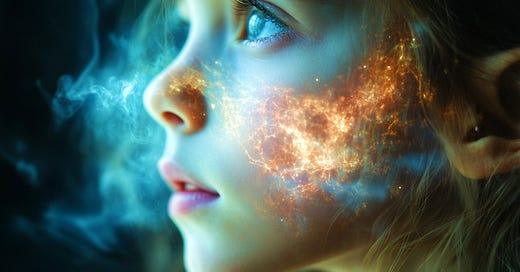Picture this: A rented house in California, stripped of mirrors, TVs, and anything reflective. Cameras are set up in every corner. In this carefully controlled space, a young girl named Mia, blindfolded and seated behind a divider, sits quietly. Her mother, on the other side, is shown randomly generated images and numbers. Then Mia does the unthinkable: she starts describing precisely what her mother is seeing.
Not once. Not twice. Every single time.
This isn’t a magician’s sleight of hand. It’s real life, captured in The Telepathy Tapes: a groundbreaking documentary that showcases the controversial research of Dr. Diane Powell, a Harvard-trained neuroscientist who dared to ask a question many consider academic heresy: What if telepathy is real?
A New Paradigm of Communication
Dr. Powell’s journey into this uncharted territory began after hearing case after case of non-verbal autistic children exhibiting astonishing mental abilities. Many of these children couldn’t speak, yet their parents reported something extraordinary: these kids seemed to know things they had no way of learning conventionally—what someone was thinking, what someone was reading in the next room, even what another person dreamed the night before.
Skepticism was Powell’s first instinct. But after meeting children like Mia, that skepticism gave way to a deeper inquiry. Powell decided to put these reported phenomena to the test under controlled conditions, as shown in The Telepathy Tapes. In one experiment, Powell ensured there were no visual cues or environmental "tells." Mia was blindfolded, flashcards and images were randomized, and the results defied statistical chance.
Mia’s correct answers weren’t just frequent, they were nearly perfect.
The Weight of Evidence vs. the Weight of Belief
In any other field of science, results with a 90%+ success rate in controlled conditions would turn heads. But when the topic is telepathy, scientific consensus often slams the door shut.
Critics of Dr. Powell’s research argue that no amount of anecdotal evidence or video documentation is enough without peer-reviewed studies that pass the most stringent controls: Faraday cages, signal-blocking rooms, and double-blind tests. Powell is the first to admit that rigorous science is essential. She’s actively working toward replicating these experiments under even stricter conditions. But it’s important to understand the practical limitations: non-verbal children, many of whom struggle with sensory overload, don’t thrive in sterile lab environments filled with fluorescent lights and strange equipment.
Yet, as Powell points out, science was never supposed to be a tool for exclusion—it’s meant to be a tool for discovery. “If these kids have the abilities I’ve seen,” she explains in one interview, “then they deserve to be seen as they truly are: extraordinary.”
And this extraordinary factor isn’t limited to one or two children. In The Telepathy Tapes, parents from around the world share eerily similar experiences. Akil, a boy from New Jersey, describes his mental link with his mother as a “shared mind.” Another young man, Houston, could pinpoint the exact page his mother was reading from two rooms away. The frequency of such reports from unrelated families suggests that we’re witnessing more than isolated anomalies; it’s a global pattern.
The Hill: Telepathy as Connection, Not Isolation
One of the most remarkable revelations from the documentary is what the non-verbal autistic community refers to as "The Hill." This isn’t a physical place—it’s a telepathic meeting ground, a shared mental space where children who have never met in person claim to communicate regularly.
The idea of “The Hill” might sound fantastical, but it’s consistent with research on nonlocality in quantum physics, where influences can defy the constraints of space and time. The research of Nassim Haramein and others suggests the existence of an invisible, inter-penetrating field of energy and information that permeates and connects all things in a manner that far exceeds Einstein’s proposed speed of light. As such, in purely theoretical terms, telepathy should not be out of the question.
Even more fascinating is how the children describe their experiences. They speak of telepathic communication as natural, instantaneous, and emotionally rich. Unlike spoken language, which can be clunky and prone to misinterpretation, telepathy conveys the fullness of thoughts—images, emotions, and sensory impressions all at once. As one child described, “If I send you the word Christmas, you don’t just get the word—you feel the lights, the music, the warmth, and the family.”
The Resistance of the Scientific Community
The Telepathy Tapes doesn’t just highlight the children’s extraordinary abilities. It also pulls back the curtain on the resistance Dr. Powell has faced. Critics from mainstream science have dismissed her work as “wishful thinking” or “pseudoscience.”
Powell’s critics often point to the lack of peer-reviewed studies in mainstream journals as a sign that telepathy research isn’t credible. But as Powell explains on her website, many scientific journals have historically rejected submissions about anomalous phenomena, regardless of the evidence. This creates a catch-22: groundbreaking research can’t gain mainstream credibility if it’s systematically barred from publication.
However, Powell is undeterred. She’s doubling down on transparency and collaboration, inviting skeptics to participate in experiments and challenging them to replicate the results themselves.
A Radical Shift in Perception
What’s at stake isn’t just whether telepathy is real; it’s a deeper question about human potential and connection. If these children can access an unspoken “language” of thoughts and feelings, what does that say about the rest of us?
In one poignant scene from the documentary, a child’s message to the world was clear: “You need to understand your feelings, because if you don’t, we feel them for you.” This isn’t just a poetic sentiment. It’s a reminder of how connected we really are.
Perhaps it’s a call to remember that consciousness itself is the invisible field that connects us all, whether we acknowledge it or not.





I'm on the spectrum, please send me an invitation to check out The Hill. :)